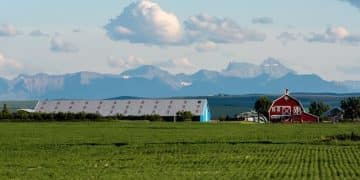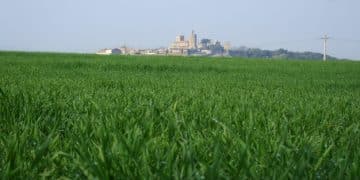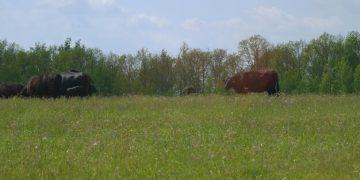How US Farmers Can Benefit from CSP in 2025

US farmers can significantly benefit from the updated Conservation Stewardship Program (CSP) in 2025 through enhanced financial and technical assistance, tailored conservation practices, and improved access to resources, leading to more sustainable and profitable farming operations.
The agricultural landscape in the United States is constantly evolving, and with it, the policies and programs that support farmers. One such program, the Conservation Stewardship Program (CSP), is set to undergo updates in 2025, promising new opportunities for US farmers. Let’s explore how can US farmers benefit from the updated Conservation Stewardship Program (CSP) in 2025.
Understanding the Conservation Stewardship Program (CSP)
The Conservation Stewardship Program (CSP) is more than just a government initiative; it’s a partnership between farmers and the US Department of Agriculture (USDA) aimed at promoting sustainable agriculture. In essence, it rewards farmers who are already implementing good conservation practices and encourages them to adopt additional ones.
CSP provides financial and technical assistance to farmers who actively manage and improve conservation practices on their land. This includes activities such as:
- Improving soil health.
- Enhancing water quality.
- Conserving energy.
- Benefiting wildlife habitat.
By participating in CSP, farmers receive payments for implementing and maintaining these conservation activities, creating a win-win situation for both the environment and their bottom line.

Key Updates to the CSP in 2025
As we look ahead to 2025, several key updates are anticipated for the Conservation Stewardship Program (CSP). These changes are designed to make the program more effective, accessible, and beneficial for US farmers. Expect some significant reforms to refine the program.
Enhanced Financial Assistance
One of the most anticipated updates is an increase in financial assistance. The USDA recognizes the importance of providing adequate compensation to farmers for their conservation efforts. The updated CSP is expected to offer:
- Higher payment rates for certain conservation activities
- Increased incentives for adopting innovative practices
- Additional financial support for farmers who implement comprehensive conservation plans
Targeted Conservation Practices
The updated CSP will likely focus on more targeted conservation practices that address specific environmental concerns. Farmers will be encouraged to implement practices that are tailored to their unique regional and environmental conditions. Some potential areas of focus include:
- Reducing nutrient runoff into waterways
- Improving air quality by reducing emissions
- Enhancing carbon sequestration in soils
- Protecting and restoring wildlife habitat
Improved Access to Resources
To ensure that farmers have the resources they need to succeed in the CSP, the updated program will likely include improved access to technical assistance, educational materials, and other support services. This may involve:
- Expanded training programs for farmers
- Increased collaboration with conservation organizations
- Development of user-friendly online tools and resources
These updates aim to make the CSP more effective and beneficial for US farmers committed to sustainable agriculture.
How Farmers Can Prepare for the 2025 CSP Changes
With the anticipated changes to the Conservation Stewardship Program (CSP) in 2025, US farmers can take proactive steps to prepare and maximize their potential benefits. Being prepared allows farmers to take full advantage of the program.
Stay Informed
The first step is to stay informed about the upcoming changes to the CSP. Farmers can follow the USDA’s website, subscribe to newsletters, and attend workshops or webinars to stay up-to-date on the latest developments. This knowledge will help them understand the new requirements and opportunities.
Assess Current Practices
Farmers should also assess their current conservation practices and identify areas where they can make improvements. This may involve conducting soil tests, evaluating water usage, or assessing wildlife habitat. By understanding their current baseline, farmers can identify the most effective conservation activities to implement under the updated CSP.
Develop a Conservation Plan
A comprehensive conservation plan can serve as a roadmap for farmers looking to participate in the CSP. This plan should outline specific conservation goals, identify the practices that will be implemented to achieve those goals, and establish a timeline for implementation. Farmers can work with conservation professionals to develop a plan that meets their unique needs and objectives.

Maximizing Benefits from the Updated CSP
Participating in the Conservation Stewardship Program (CSP) can provide numerous benefits for US farmers, but it’s essential to maximize these advantages through strategic planning and implementation. By taking the proper steps, farmers can fully benefit from the program.
Tailor Practices to Your Farm
One of the key aspects of the CSP is its flexibility, allowing farmers to tailor conservation practices to their specific farm operations, resource concerns, and environmental goals. Farmers should carefully evaluate their options and select practices that align with their unique circumstances. Factors to consider may include:
- Soil type and health
- Water availability and quality
- Climate and weather patterns
- Existing infrastructure and equipment
Integrate Conservation into Farm Management
To truly maximize the benefits of the CSP, farmers should integrate conservation into their overall farm management strategy. This means considering the environmental impacts of all farming activities, from planting and harvesting to livestock management and energy consumption. By adopting a holistic approach to conservation, farmers can create a more sustainable and resilient operation.
Monitor and Evaluate Progress
Regular monitoring and evaluation are essential for tracking the effectiveness of conservation practices and making adjustments as needed. Farmers should establish clear metrics to measure the success of their conservation efforts and regularly collect data to assess progress. This may involve:
- Tracking soil health indicators
- Monitoring water quality
- Assessing wildlife populations
- Measuring energy consumption
By staying informed, proactive, and strategic, US farmers can reap the full rewards of the updated CSP in 2025.
Success Stories: CSP in Action
The Conservation Stewardship Program (CSP) has already made a significant impact on farms across the United States. Examining success stories helps to see what types of farming can be optimized under the program. Let’s take a closer look at some inspiring examples of how farmers are using CSP to achieve their conservation goals.
Improving Soil Health
One farmer in Iowa used CSP to implement cover cropping and no-till farming practices, resulting in significant improvements in soil health. Soil organic matter increased, erosion decreased, and water infiltration improved. The farmer also reported higher crop yields and reduced fertilizer costs.
Enhancing Water Quality
A rancher in Montana used CSP to implement rotational grazing and riparian buffer practices, which helped to reduce nutrient runoff into nearby streams. Water quality improved, and the rancher also saw an increase in forage production and improved livestock health.
Benefiting Wildlife Habitat
A farmer in California used CSP to restore and enhance wildlife habitat on their property. They planted native trees and shrubs, created wetlands, and installed birdhouses. As a result, they saw an increase in bird and pollinator populations, as well as improved pest control.
These are just a few examples of how CSP can help farmers achieve their conservation goals while also improving their bottom line. By sharing these success stories, we can inspire other farmers to participate in the program and create a more sustainable agricultural future.
Overcoming Common Challenges in CSP Participation
While the Conservation Stewardship Program (CSP) offers numerous benefits, farmers may encounter challenges during the application and implementation process. Knowing how to overcome these roadblocks can allow farmers to more easily adopt the program. Let’s discuss some common challenges and potential solutions.
Complexity of Application Process
Some farmers find the CSP application process to be complex and time-consuming. To address this challenge, the USDA offers technical assistance to help farmers navigate the application process. Farmers can also seek guidance from conservation organizations or other experienced CSP participants.
Limited Technical Assistance
Another challenge is the limited availability of technical assistance in some areas. To overcome this issue, farmers can explore alternative sources of technical support, such as private consultants, university extension programs, or online resources.
By acknowledging and addressing these challenges proactively, US farmers can overcome barriers and fully participate in the CSP, contributing to a more sustainable and resilient agricultural sector.
| Key Point | Brief Description |
|---|---|
| 🌱 Soil Health | Improve organic matter and reduce erosion through cover crops. |
| 💧 Water Quality | Reduce runoff with buffer strips and efficient irrigation. |
| 🦋 Wildlife Habitat | Create habitats for pollinators and other beneficial species. |
| 💰 Financial Assistance | Get paid for implementing and maintaining conservation efforts. |
Frequently Asked Questions (FAQ)
▼
The CSP is a voluntary program that provides financial and technical assistance to farmers who actively manage and improve conservation practices on their land. It focuses on rewarding farmers for addressing resource concerns. The program can address a wide range of farming types in the US.
▼
To apply, contact your local USDA Natural Resources Conservation Service (NRCS) office. They can guide you through the application process, help you develop a conservation plan, and answer any questions you may have. You can also find information on the USDA website, which is a great resource.
▼
A wide range of conservation practices are eligible for CSP payments, including cover cropping, no-till farming, rotational grazing, and wildlife habitat enhancement. The specific practices that are eligible will depend on the resource concerns in your area, so check with your local NRCS office.
▼
▼
If you don’t fulfill your CSP contract, you may be required to refund a portion of the payments you have received. It’s important to carefully consider your ability to implement the conservation practices outlined in your contract before you sign it. Communication is key to avoiding issues.
Conclusion
As US farmers look to the future, the updated Conservation Stewardship Program (CSP) in 2025 offers a valuable opportunity to enhance their farm’s sustainability and profitability. By staying informed, assessing current practices, and developing comprehensive conservation plans, farmers can maximize the benefits of this program and contribute to a more resilient agricultural sector for generations to come.





